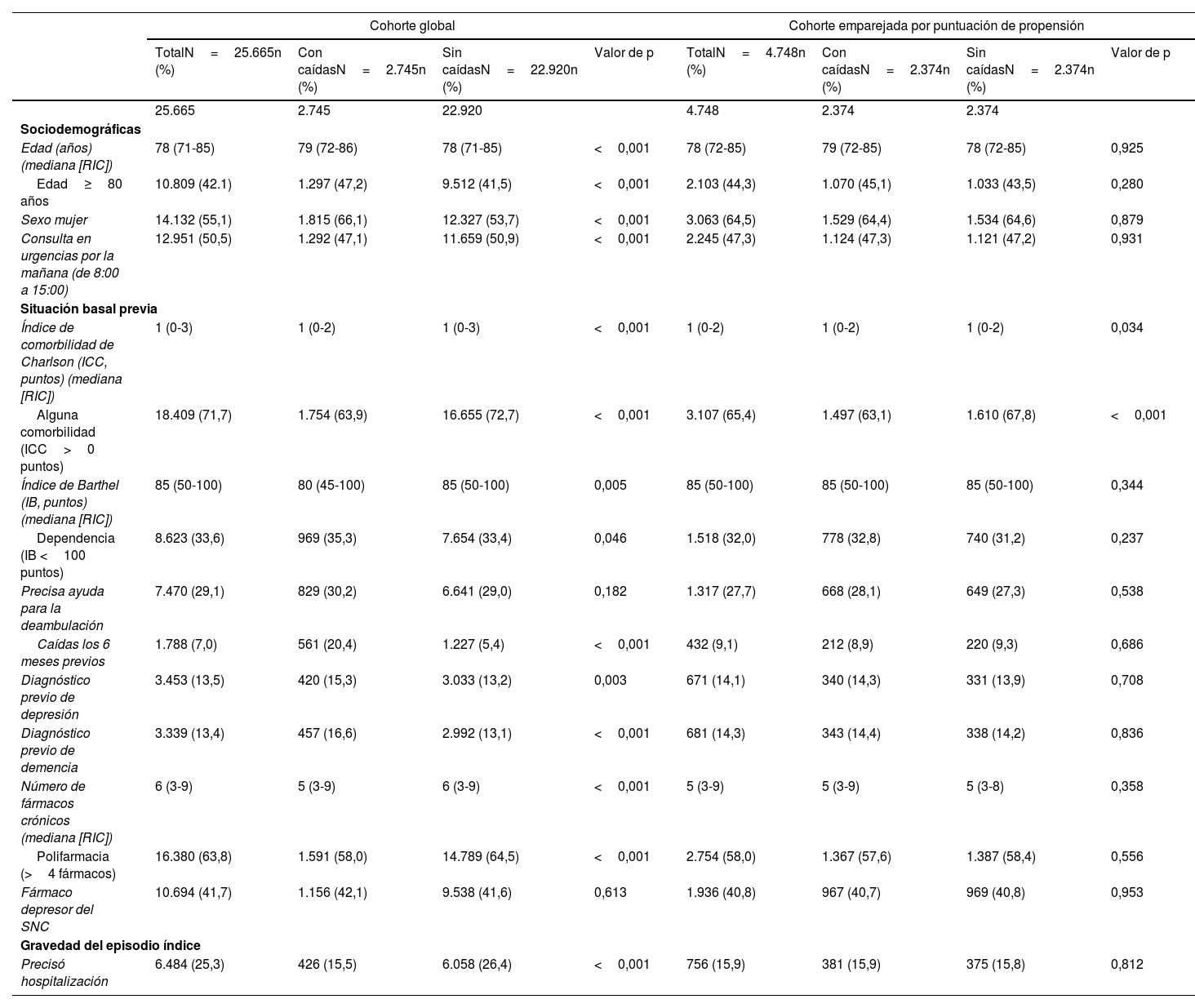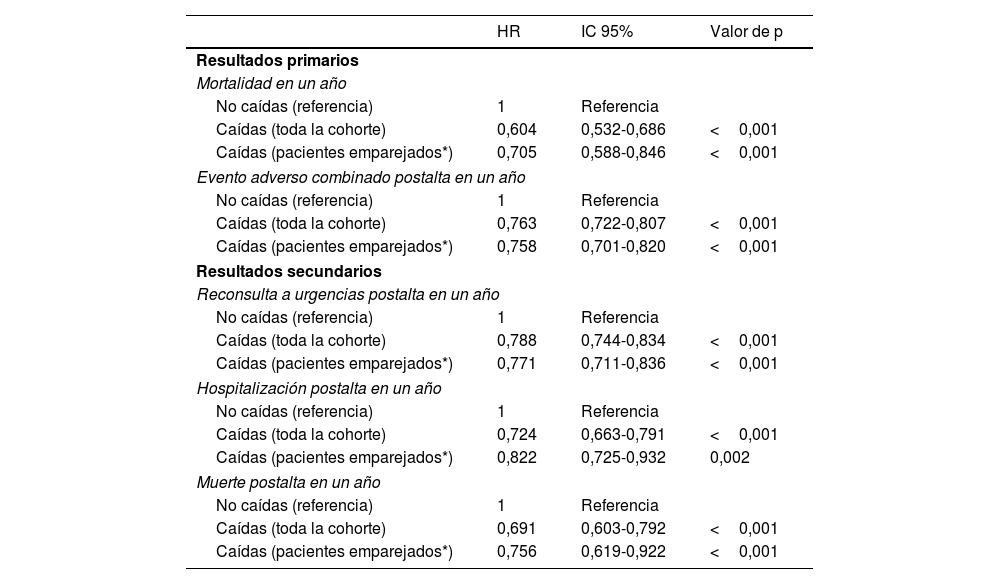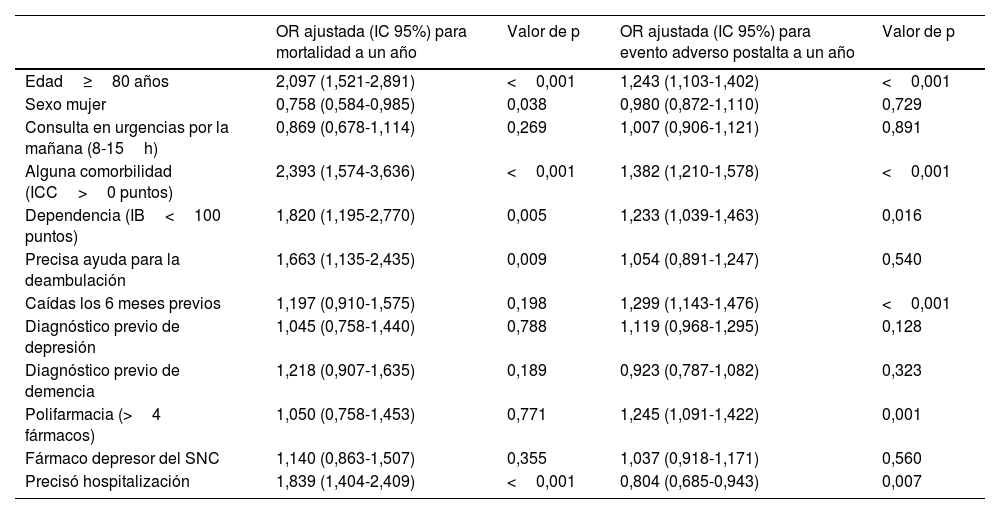Investigar si las caídas en las personas ≥65 años son un factor pronóstico de eventos adversos comparado con el resto de pacientes mayores que consultan en los servicios de urgencias e identificar los factores relacionados con una peor evolución a largo plazo.
MétodoCohorte EDEN que incluyó pacientes ≥65 años. Se distinguió aquellos pacientes que consultaron por caída y el resto. Se recogieron 12 variables. Para la comparación: 2 grupos emparejados por puntuación de propensión de caer. Se comparó la mortalidad al año y el evento adverso combinado postalta al año. En los pacientes con caídas, se identificaron las variables relacionadas independientemente con la evolución mediante regresión multivariante.
ResultadosDos mil setecientos cuarenta y cinco pacientes atendidos por caídas y 22.920 por otros motivos. La mortalidad al año fue del 14,4% (9,5 vs. 15,0%, respectivamente; p<0,001) y el evento adverso combinado postalta al año del 60,6% (52,2 vs. 61,7%, respectivamente; p<0,001). En 4.748 pacientes emparejados por puntuación de propensión a caída (2.372 en cada grupo), se mantuvo significativa la asociación inversa entre consulta por caída y mortalidad (HR: 0,705; IC 95%: 0,588-0,846) y evento adverso combinado postalta (0,758, 0,701-0,820). Factores asociados con mortalidad en pacientes con caídas fueron ≥80 años (2,097, 1,521-2,891) y comorbilidad (2,393, 1,574-3,636) y ser mujer fue factor protector (0,758, 0,584-0,985). Entre los factores asociados con evento adverso combinado postalta, la hospitalización en evento índice fue factor protector (0,804, 0,685-0,943).
ConclusionesLos pacientes mayores de 65 años atendidos en urgencias por caída tienen mejor pronóstico. La hospitalización fue un factor protector de evento adverso combinado postalta.
To investigate whether falls in people ≥65 years old are a prognostic factor for adverse events compared to the rest of older patients who consult emergency departments, and identify factors related to a worse long-term evolution.
MethodEDEN cohort that included patients ≥65 years old. Those patients who consulted for fall and the rest were distinguished. Twelve variables were collected. For comparison: two groups matched by fall propensity score. We compared mortality at one year and combined adverse event post-discharge at one year. In patients with falls, variables independently related to evolution were identified.
ResultsTwo thousand seven hundred and forty-five patients treated for falls and 22,920 for other reasons. Mortality at one year was 14.4% (9.5% vs. 15.0%, respectively, P<.001) and the combined post-discharge adverse event at one year was 60.6% (52.2% vs. 61.7%, respectively, P<.001). In 4748 patients matched by fall propensity score (2372 in each group), the inverse association between consultation for fall and mortality (HR: 0.705, 95% CI: 0.5880.846) and post-discharge combined adverse event (0.758, 0.701-0.820) remained significant. Factors associated with mortality in patients with falls were ≥80 years (2.097, 1.521-2.891) and comorbidity (2.393, 1.574-3.636) while being female was a protective factor (0.758, 0.584-0.985). Between the factors associated with post-discharge combined adverse hospitalization in the index event was a protective factor (0.804, 0.685-0.943).
ConclusionsPatients over 65 years of age treated in the emergency room for falls have a better prognosis. Hospitalization was a protective factor of combined postdischarge adverse event.
Artículo
Comprando el artículo el PDF del mismo podrá ser descargado
Precio 19,34 €
Comprar ahora













